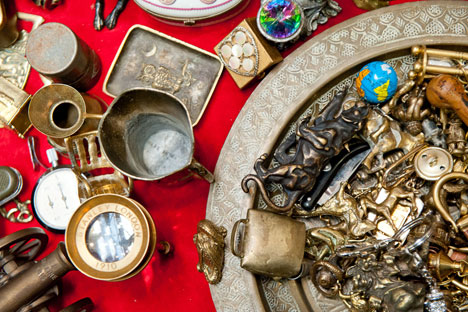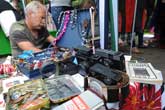Flea markets: Searching for gems in junk

Source: Anton Agarkov
Before World War II, Tishinskaya Square used to be home to a huge market — one of the biggest in Moscow. In the ‘60s–‘90s, it turned into a major draw for trendy youth, as a place where one could find unique stuff for pocket change. It was a Mecca for local fashionistas, even in those times of ubiquitous deficit and scarce income.
One of the most successful and well-known Tishinka customers was Alexander Petlura — artist, designer, and founder of the bohemian Moscow “art-squat” of the ‘90s. Much of his fame originates from his impressive collection of rare items found in scrap heaps and at flea markets.
This made him a most-valued client in Tishinka, and local elderly ladies would keep their treasures especially for him. The contemporary fair is just a shadow of the former flea market; the Tishinka market itself was replaced by a shopping center.
However, there still remain some authentic places. In St. Petersburg, there is still a place called Udelnaya that is considered the main flea market in Russia. The Mark railway platform used to be home to semi-legal trade in Moscow for a while: This place was truly authentic and a hardcore experience for those prepared for it.
One had to get there by railway and then follow the long trading rows running for miles right from the platform.
No one spoke a word of English, the produce was put on display on scraps of newspaper and cloth right on the ground, and most of the vendors were reminiscent of characters from Maxim Gorky’s “Na Dne” (“The depths”).
Yet just 30 rubles could buy a strange, rug-knit umbrella, a tiny teaspoon, a linen wedge cap with an embroidered airplane, and a Korean pin with a flashlight. In 2010, the flea market moved to the Novopodrezkovo platform (destination St. Petersburg) and became more civilized. Even so, it is still deemed the most authentic, despite never-ending rumors about its imminent shutdown.
That being said, there are markets promoted by the Moscow authorities that are well-equipped and easily accessible. These offer a half-way solution by giving space to both poor pensioners selling their own things and antique shops.
One such market is located in northeast Moscow, just a 10-minute walk from the Partizanskaya metro station. The sign “Vernisazh” marks the start of the boulevard leading to the multicolor domes of the Izmailovsky Kremlin — a fascinating white brick palace resembling the main Moscow Kremlin in Red Square.
It houses a large collection of miscellaneous things, including cafes, a rifle range, a soap manufacturer, a belfry and a few museums — a museum of bread and Russian toys, a museum of vodka and the history of the Russian fleet.
Trade starts at the very entrance, where elderly yet spirited women make old spoons and forks and past years of magazine issues available. This is a lucrative spot that guarantees a bonus to their small pension.
A man asks one of the sellers the price of a tin with a picture of a sturgeon on it—the kind of tins in which black caviar used to be sold. It costs 300 rubles (about $10). The elderly lady adds: “But it’s from the 50s!” Nearby, a fashionably dressed girl in rubber boots and a bright-colored coat excitedly yells into her iPhone: “Just got a super gramophone — and it works!”
Related:
How to get a good deal in a Moscow market
A culinary daydream back to the Soviet Union
Among figs, cumin and pomegranate, a stunning catwalk emerges
No doubt, this is the place to go for souvenirs. If you take it seriously and do not grab the first flashy matryoshka you see, you can find something truly memorable, unique and valuable. You are not likely to get it cheap, though.
The vendors make their profit from tourists, so the prices are mostly far from modest. Still, foreigners are treated with much respect, and most sellers can sport some English.
In the Aviator shop, you can get a lovely pilot watch from the famous firms Polet and Buran for 4,000 rubles on average. In a few feet, you will come across the same watch — not brand new, but with a history going back to the early ‘40s — and for half that price.
The seller says that he competes with a few collectors. All the watches work; some of them are assembled to match old models that have never been in use.
On the weekends, the selection is large — especially in the morning. On weekdays, just two rows are open and, after 5 p.m., they wrap up the commerce. The Vernisazh wooden stalls carved in Slavonic style create the atmosphere of a true Russian fair.
All national crafts are represented here — laces, shawls, Pavloposad scarves, ceramics, blacksmith and leather shops, skins of wild animals, amber, crystal, etc. Some rows have thematic names: “crafts street,” “painting street,” “icon row.”
The history of the country flows in front of your gaze, from stall to stall — military uniform, divers’ suits, Lenin’s busts (the smallest would cost you about 1,500 rubles). Even the Belomor cigarettes, which were popular in Soviet times — and which can still be found on sale for a few kopeks — cost 350 rubles here. A ruffled pack from those far off days is already an antique item.
Most vendors are collectors. A man in his fifties and wearing a sailor shirt talks about his huge stall full of pins: “This is nothing — just 20 percent of what I’ve got. Not everything, but what I have on me today… I’ve been collecting pins since I was 20, and I know other collectors, of course. It’s impossible to be on your own, you have to exchange constantly. These airplanes over here are modern, produced on order for 500-700 rubles, but they are in huge demand. And this owl and a pin that looks like Batman are emblems of various intelligence departments. Sports symbols also sell well; there’ll be a match tonight, seems like the fans have come by for some souvenirs…”
Not all items are rare and antique. Very often, they are just stylized — like when modern masters decorate old wooden utensils in Slavonic style.
A heated conversation between a vendor and an aristocratic-looking female customer wearing signets is overheard:
“If this was at least made by the modern craftsmen from the villages like Fediskino, this could have some value! But the Russian village is destroyed, as well as its crafts and soul!”
“It’s impossible to revive the dead, madam! Have you heard of the artist Galina Maslennikova? She has been reviving the crafts in her native village. And what is the outcome? Drinking parties over there! Speaking of art…”
Nearby there are exquisitely painted broaches on sale from Fediskino, famous for its school of miniature painting. Seek and ye shall find.
All rights reserved by Rossiyskaya Gazeta.
Subscribe
to our newsletter!
Get the week's best stories straight to your inbox

